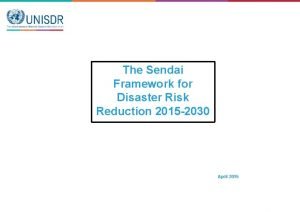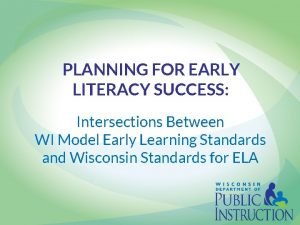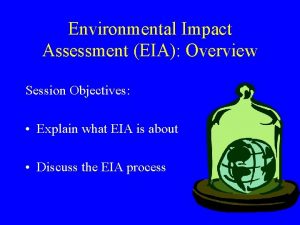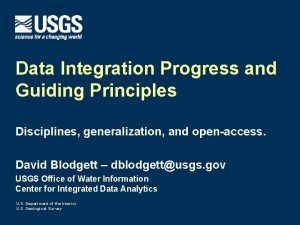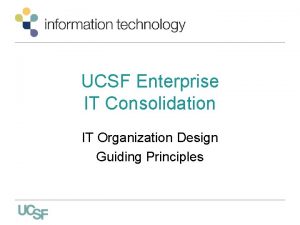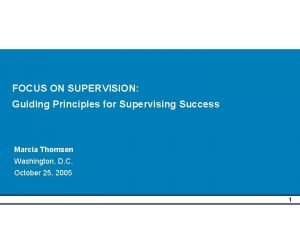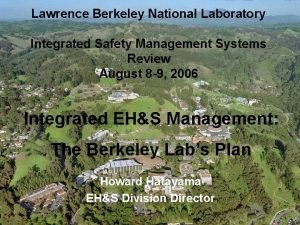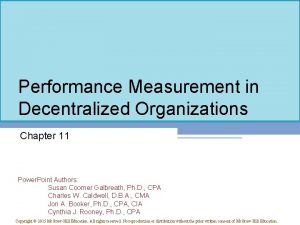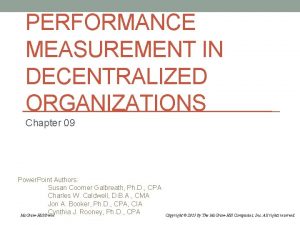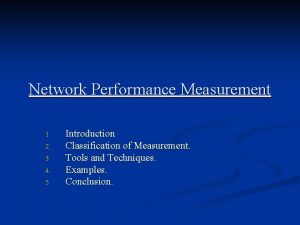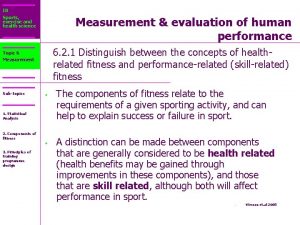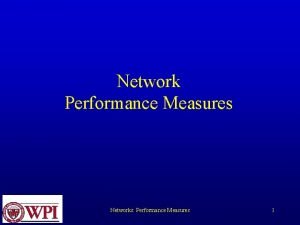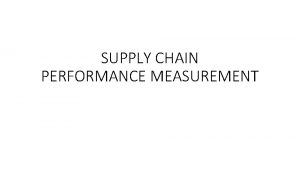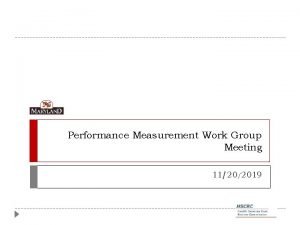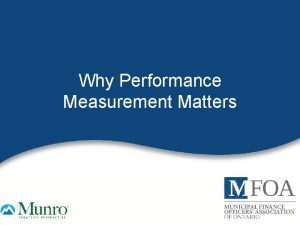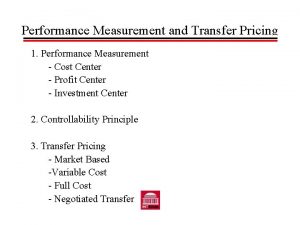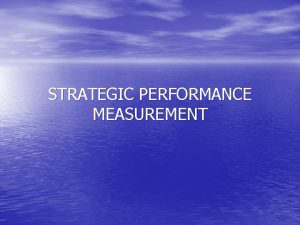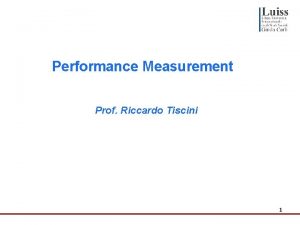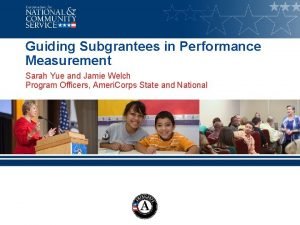Performance Measurement Work Group Meeting 12192018 Guiding Principles





































- Slides: 37

Performance Measurement Work Group Meeting 12/19/2018

Guiding Principles For Performance-Based Payment Programs ▶ Program must improve care for all patients, regardless of payer ▶ Program incentives should support achievement of all payer total cost of care model targets ▶ Promote health equity while minimizing unintended consequences ▶ Program should prioritize high volume, high cost, opportunity for improvement and areas of national focus ▶ Predetermined performance targets and financial impact ▶ Hospital ability to track progress ▶ Encourage cooperation and sharing of best practices ▶ Consider all settings of care 2

Agenda ▶ ▶ 1. Welcome and Introductions 2. RY 2021 RRIP Policy Draft ▶ Updated Targets ▶ Revenue adjustment scale 3. RY 2021 MHAC Policy Proposed Methodology Changes ▶ Targeted PPC list reliability analysis ▶ Revenue adjustment scale ▶ Revenue at risk 5. FY 2020 PAU Proposed Updates Modeling 3

Welcome and Introductions 4

RY 2021 RRIP Policy

Medicare Waiver Test: At or below National Medicare Readmission Rate by CY 2018 With most recent Medicare Readmissions data, Maryland’s Medicare Readmission Rate (15. 38%) is just below the National Medicare Readmission Rate (15. 42%). Maryland will need to continue to reduce its readmissions, and match any additional reduction in the national rate. Data are currently available through July 2018 6

HSCRC data aligns well with CMMI data Readmissions 2013 - Present 19, 50% 18, 50% 17, 50% 16, 50% 15, 50% 14, 50% 13, 50% Jan Jan Jan 2013 2013 2013 2014 2014 2014 2015 2015 2015 2016 2016 2016 2017 2017 2017 2018 2018 2018 CMMI MD Rate HSCRC Medicare Rate 7

Monthly Case-Mix Adjusted Readmission Rates ICD-10 Case-Mix Adjusted Readmissions RY 2018 Improvement (CY 13 CY 16) 2016 Jan-September YTD CY 2018 Jan-September YTD RY 2020 YTD Improvement RY 2020 Compounded Improvement All-Payer Medicare FFS -10. 79% -9. 92% 11. 79% 11. 15% -5. 41% 12. 67% 11. 84% -6. 58% -15. 61% -15. 85% 8 Note: Based on final data for Jan 2013 – Mar 2018; Preliminary data through September 2018. Statewide improvement to-date in RY 2020 is compounded with RY 2018 improvement.

Flowchart of Predicting Improvement Target Step 1 Step 2 Step 3 Step 4 9 • Project CY 2019 National Medicare rates [15. 34%] • Add a cushion to Medicare projections [15. 24%, 15. 14%; 15. 04%] • Convert National (projected) rate to All-Payer Case-mix Adjusted Rate* [11. 55%; 11. 48%; 11. 40%] • Calculate 2016 -2019 Improvement Target (RY 2021) [3. 24%; -3. 88%; -4. 51%] HSCRC expects to have more recent data to improve predictions for final policy.

Flowchart of Predicting Attainment Target Step 1 Step 2 Step 3 Step 4 10 • Take Current All-Payer Case-mix Adjusted Readmission Rates (2018 YTD through Aug) • Increase these rates for Out-of-State Readmissions (Jul 17 -Jun 18) • Using CMMI data, the ratio is as follows: • Calculate the 35 th and 5 th percentiles for the statewide distribution of scores • 35 th Percentile is threshold to receive attainment point rewards (11. 19%) • 5 th Percentile is benchmark to receive maximum attainment point rewards (8. 76%) • Adjust benchmark and threshold downward 2. 01%, per principles of continuous quality improvement Threshold: 10. 96%; Benchmark: 8. 59%

RY 2021 Proposed Revenue Adjustment Scales (Better of Attainment or Improvement All Payer Readmission Rate Change CY 16 -CY 19 A Improving Readmission Rate Target Worsening Readmission Rate 11 -15. 01% -9. 76% -4. 51% 0. 74% 5. 99% 11. 24% 16. 49% RRIP % Inpatient Revenue Payment Adjustment All Payer Readmission Rate CY 19 B 1. 0% 1. 00% 0. 50% 0. 00% -0. 50% -1. 00% -1. 50% -2. 0% Lower Absolute Readmission Rate Benchmark Threshold Higher Absolute Readmission Rate RRIP % Inpatient Revenue Payment Adjustment A B 8. 59% 9. 77% 10. 96% 12. 15% 13. 34% 1. 00% 0. 50% 0. 00% -0. 50% -1. 00% 14. 52% 15. 71% -1. 50% -2. 0%

Staff Draft Recommendations for RY 2021 RRIP Policy ▶ ▶ ▶ Measure hospital performance as the better of attainment or improvement. Set the all-payer case-mix adjusted readmission rate improvement target at 4. 51 percent for CY 2016 to CY 2019. Set the attainment performance standards for CY 2019 with an expanded benchmark and threshold range as follows: ▶ ▶ ▶ Use CY 2018 YTD hospital performance results with an improvement factor added. Increase threshold where hospitals start to earn rewards from the 25 th percentile to the 35 th percentile, which is 10. 96 percent. Decrease the benchmark where hospital receive the full 1 percent reward from the 10 th percentile to the 5 th percentile at 8. 59 percent. Include admissions to specialty hospitals in the calculation of acute care hospital readmission rates and monitor readmission rates of specialty hospitals. Set the maximum reward hospitals can receive at 1 percent of inpatient revenue and the maximum penalty at 2 percent of inpatient revenue. 12

Proposals for 2019 Sub-Group ▶ Staff will convene readmission subgroup in early 2019 to consider issues, such as: ▶ ▶ ▶ Attainment vs Improvement Socio-demographic risk-adjustment for attainment only program Shrinking denominator issue and per capita approaches By payer data sources for benchmarks Observation stays Those interested in participating in subgroup should email hscrc. quality@maryland. gov and provide brief bio and reason for interest 13

RY 2021 MHAC Policy

RY 2021 MHAC Program Updates Decision Points ▶ ▶ Narrowed down, targeted measure list Cost-weights ▶ ▶ ▶ Review of updated 3 M Cost Weights- pending release Attainment-only Reliability/Zero-Norm Concern ▶ Analysis of 80% exclusion--impact on RY 2020 Narrowed down PPC list ▶ Decision on revenue at-risk and adjustment scale ▶ Expanded Scoring Methodology Revenue At-Risk and Adjustment Scale 15 √ √ √

Review: Measure Selection ▶ ▶ For payment program, proposing 14 PPCs with higher rates, variation, and clinical support No national comparison, but 3 M is developing national norms under v 36 that should be available in early 2019 In future years, staff will assess AHRQ Patient Safety indicators or other new measures that have national comparability Review histogram handout 16

Zero-Norm Concerns and Clinical Alignment ▶ Goals - Payment program should: ▶ ▶ Adjust measures to account for case-mix differences across hospitals Include measures that provide clinical opportunities for quality improvement ▶ Concern: ▶ Case-mix adjustment calculates expected values using statewide averages by diagnosis and severity, high percentage of “zero-norms” ▶ Approaches to address concern (RY 2020; interim suggestion): ▶ ▶ ▶ Measure performance on the diagnosis and PPC combos where at least 80% of complications occur Raise minimum at-risk number to focus on larger patient populations and require at least one expected PPC for hospital to be assessed Approaches to address concern (RY 2021 and ongoing): ▶ 17 Narrowed down PPC list to PPCs with higher rates and variation, and are clinically supported

RY 2020 YTD Results: 80% Exclusion ▶ RY 2020 YTD results (through June) show that only 65% of PPCs are included in the payment program, with only three hospitals having > 80% of PPCs included HSCRC staff are concerned that the 80% methodology excludes high percent of PPCs in performance period Staff believes that it is not necessary to restrict PPC measurement beyond the 3 M clinical logic with the narrowed down PPC list 18

Narrowed PPC list reduces Zero Norm Staff Recommendation: Remove temporary restriction to APR-DRG SOI and PPCs where 80% of PPCs occur. 19

Attainment Only Program ▶ Use wider range of performance standards and more granular points under attainment only approach: ▶ Proposed approach: Assign 0 -100 points based on the 10 th and 90 th percentile of historical performance The wider threshold and benchmark differentiates hospital performance at the lower and upper ends 20

Current RY 2021 Modeling ▶ ▶ PPC Grouper v 35 CY 2016 is used to calculate normative values and performance standards Performance period: April 2017 to March 2018 Three models all using narrowed down PPC list and 3 M cost weights: ▶ ▶ ▶ 21 Model 1: Current threshold and benchmark, 0 -10 points, improvement and attainment Model 2: Current threshold and benchmark, 0 -10 points, attainment only Model 3: Expanded performance standards attainment only

Thresholds and Benchmarks 22

Hospital Scores & Revenue Adjustments ▶ ▶ ▶ Hospitals continue to want a prospective revenue adjustment scale that does not relatively rank hospitals Current scale is based on mathematical range of scores from 0% to 100%, with a “hold harmless zone” between 45% and 55% Linearly scales penalties and rewards, with a max penalty of 2% and max reward of 1% of inpatient revenue How should revenue adjustment scale be modified to reflect higher scores under expanded scoring methodology? 23

Discussion: Where to move cut-point under 0 -100 Scoring Methodology? ▶ ▶ Cut-point must be greater than 50%; likely below 80% Options: ▶ Apply change in average scores (base to perf) to determine cut-point ▶ ▶ ▶ Calculate attainment only scores using 2013 norms and performance standards, calculate with 30% improvement, average the attainment-only scores to generate cut-point Calculate O/E ratio for each PPC at selected percentile of statewide performance for rewards and calculate score ▶ ▶ 24 20% incr. in average score would increase 50% cut-point to 60% 50 th percentile of base on all PPCs = 56% hospital score 75 th percentile of base on all PPCs = 79% hospital score

Policy Considerations Continuous Incentives Focus on Outliers Non-Linear Scaling of Penalties and Rewards 25

Revenue Adjustment Modeling 26

RY 2021 MHAC Draft Recommendations Staff Recommendations: ▶ Include 14 PPCs in payment program; monitor other PPCs ▶ Move to attainment only measurement with more granular scoring methodology ▶ Weight PPCs in payment program by 3 M cost weights PMWG Discussion to inform: ▶ Set max penalty at 2% and max reward at 1% and use continuous non-linear scaling with a 65% cutpoint 27 Max Penalty Max Reward Cut Point or Hold Harmless Zone Scaling Option -2. 0% 1. 0% 60 -70% Linear -1. 5% 0. 75% 60 -70% Linear -2. 0% 1. 0% 65% or other calculated cut-point Non-linear

Potentially Avoidable Utilization (PAU) 28

Timeline ▶ PAU savings policy is approved by Commission at the same time as the update factor (June preceding rate year). ▶ ▶ Different from other quality policies that are approved before the performance period In order for hospitals to monitor performance during the performance period, staff is building reporting to reflect potential staff recommendations for RY 2020 and RY 2021 ▶ However, no decisions are final until approved by Commission. PAU Savings Timeline RY 2020 RY 2021 Performance Jan 2018 -Dec 2018 Jan 2019 -Dec 2019 Commission Approval June 2019 June 2020 29

Potential changes for RY 2020 Reporting (CY 2018) ▶ ▶ Keep RY 19 measures but count readmission revenue for the sending hospital instead of the receiving hospital. Staff plans to produce CY 18 final reports with both old and new methodology 30

Potential changes for RY 2021 Reporting (CY 2019) ▶ Summary of reporting changes under consideration: ▶ Change to readmissions at the sending hospital ▶ Add pediatric avoidable admission measures ▶ Implement per capita approaches for PQIs and readmissions ▶ Staff aiming to produce updated reporting in early 2019 so input in the next month or so is critical. ▶ Again, no RY 2021 measure changes are final until approved by Commission 31

Review of per capita options ▶ Geographic ▶ ▶ Direct ▶ ▶ Attributes PQIs and population to one or more hospitals based on patient residence and hospital service areas, regardless of which hospital treated the PQI Attributes PQIs to hospital that treated the PQI, if the patient’s residence is in the hospital’s service area. Attributes population based on hospital service areas. Provider/Geography (aka MPA) ▶ Attributes patients and corresponding PQIs to hospitals based on outside algorithm. Remaining PQIs attributed to hospitals based on geography

Provider/Geography Attribution Approach Stakeholder interest in using patient-provider-hospital relationships to help attribute PQIs ▶ Medicare Performance Adjustment (MPA) is the only HSCRC methodology currently linking patients to providers to hospitals ▶ ▶ MPA attributes Medicare beneficiaries to primary care providers based on primary care use, and then links providers with hospitals based on existing relationships ▶ ▶ Those not linked to a primary care provider are attributed based on geography (<15% of PQIs) Could envision similar approaches for other payers, but do not currently have existing mechanisms/data

PQI Per Capita Reporting: Staff Assessment ▶ ▶ For PQIs/PDIs, use Provider/Geography approach Rationale ▶ May help align hospital efforts across programs ▶ ▶ Focus on the same population Reduces overlapping responsibility May be more actionable for hospitals Keeps geographic approach for pediatric patients Data/Logistical Concerns ● ● ● Different attribution for different payers Case-mix and CCLF data (MPA data source) may not tie together exactly Reliant on MPA attribution ○ Any changes to MPA attribution would impact PAU ○ Revised MPA attribution likely not finalized until after January

Adult PQI modeling ▶ Modeling (table below) shows 2017 adult PQIs attributed under the Provider/Geography approach: ▶ ▶ ▶ Medicare FFS PQIs and population are attributed to hospitals using MPA Then non-Medicare FFS PQIs and population are attributed to hospitals using geographic approach Total adult PQI per capita would be used as the performance measure, but additional per capitas are presented for reference 2017 PQIs Adult Population Per capita (per 100 k) 1. Provider-based (MPA, adult) 41, 560 733, 162 5, 669 2. Geographic (adult) 31, 104 3, 989, 727 780 Total Adult PQIs 72, 664 4, 722, 889 1538 ▶ Over 50% of all 72, 664 Maryland adult PQIs in 2017 could be attributed to a hospital through the RY 2020 MPA. 35

Pediatric modeling ▶ Table below shows modeling for 2017 PQIs/PDIs for the pediatric population using the geographic approach PQIs/PDIs Total Adult Total Pediatric Total ▶ Population Per capita (per 100 k) 72, 664 4, 722, 889 1538 7, 005 1, 352, 020 518 79, 669 6, 074, 909 1, 233 Using the geographic method, all hospitals would be partially accountable for pediatric patients. ▶ In contrast in 2017, seven hospitals received more than 50% of all low birthweight and PDI discharges. 36

Readmit per Capita Reporting: Staff Assessment to date ▶ If a discharge is both a PQI/PDI and a readmission, count it as a PQI (currently counted as a readmit) ▶ Statewide, 20% of readmissions were attributed as PQIs. ▶ Attribute non-PQI/PDI readmission to sending hospital if the patient resides in the sending hospital’s PSAP ▶ Rationale ● ● ● Excludes 40% of readmissions that occur outside of the sending hospital’s PSAP 2017 Readmit per capita Modeling Readmits Focuses PAU readmissions measure on discharge planning and follow-up within a hospital’s community Direct approach provides greater link to hospitals discharging patients compared to MPA Limited comprehensiveness may be an acceptable tradeoff, especially given all readmissions included in RRIP Population Per capita Sending hospital’s PSAP 33, 954 6, 064, 173 560 Outside sending hospital’s PSAP 23, 917 - -
 Priority of sendai framework
Priority of sendai framework Wmels 9 guiding principles
Wmels 9 guiding principles National curriculum framework
National curriculum framework Guiding principles for teaching and learning in mtb-mle
Guiding principles for teaching and learning in mtb-mle Mcpon guiding principles 2021
Mcpon guiding principles 2021 Eight guiding principles of eia
Eight guiding principles of eia Integration guiding principles
Integration guiding principles Org design guiding principles
Org design guiding principles Project portfolio management guiding principles
Project portfolio management guiding principles Enterprise architecture alignment
Enterprise architecture alignment Guiding principles for dual language education
Guiding principles for dual language education Na guiding principals
Na guiding principals Guiding principles of supervision
Guiding principles of supervision Importance of green management
Importance of green management Madrid guiding principles
Madrid guiding principles Isms guiding principles
Isms guiding principles Delegative leadership
Delegative leadership Models of social group work pdf
Models of social group work pdf Team vs group
Team vs group Smart work vs hard work group discussion
Smart work vs hard work group discussion For today's meeting
For today's meeting Proposal kickoff meeting agenda
Proposal kickoff meeting agenda What is meeting and types of meeting
What is meeting and types of meeting What is meeting and types of meeting
What is meeting and types of meeting Performance measurement in decentralized organizations
Performance measurement in decentralized organizations Performance measurement in decentralized organizations
Performance measurement in decentralized organizations Network performance measurement tools
Network performance measurement tools Nist sp 800-55
Nist sp 800-55 Approaches to measuring performance
Approaches to measuring performance Comparative performance measurement system
Comparative performance measurement system Defining performance and choosing a measurement approach
Defining performance and choosing a measurement approach Progress and performance measurement and evaluation
Progress and performance measurement and evaluation Network performance measurement tools
Network performance measurement tools Measurement and evaluation in human performance 5e download
Measurement and evaluation in human performance 5e download Vertical jump adalah
Vertical jump adalah Quantum performance measurement
Quantum performance measurement Evaluation in progress
Evaluation in progress Network performance measures
Network performance measures
